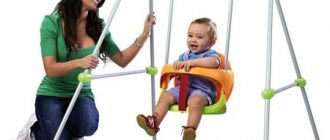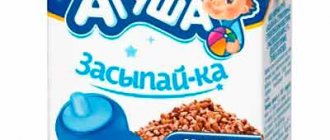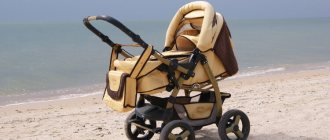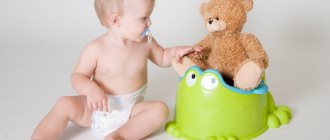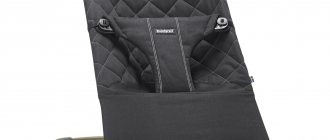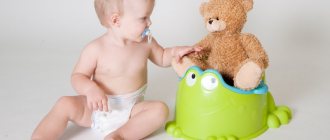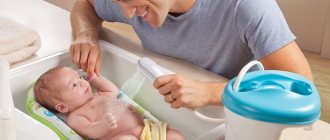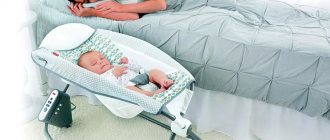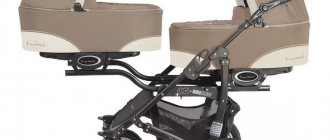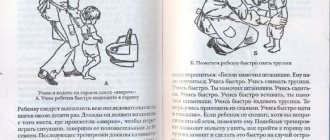As a rule, a newborn baby’s crib is purchased shortly before he is born. At the same time, many young parents pay attention mainly to its appearance. But, seduced by the bright colors, many pay fabulous sums, without even asking what this miracle that captivated them is made of.
When choosing a crib, you cannot be guided by “beauty” alone. There are many important points to take into account.
A children's room without furniture is like a house without a roof. A crib, chest of drawers, cabinet, changing table - these are the main items that should be in a newborn’s room. As the baby grows and matures, so will his wealth of furniture. In the meantime, the crib is almost his only refuge. It is desirable that it meets all the needs of the child and fits into the interior of the children's room.
The crib must “breathe”
When you come to a children's store, your eyes widen: there is so much that you sometimes forget why you came. There are also many varieties of cribs: there are cradles for babies, cribs-“houses” - with a canopy in the form of a roof, and beds in the “European standard” style - painted white, and even pretending to be Gothic style; there are also simpler products. Do not buy anything under the influence of first emotions.
As soon as the first excitement has subsided, estimate your financial capabilities and begin a thorough inspection. Sellers often especially praise more expensive goods. But price is not an indicator of quality. First of all, pay attention to the material from which the crib is made. Natural wood has always been considered the best.
Wood is an environmentally friendly material; it “breathes” itself and allows others to “breathe.” It is easy to wash, making it easy to keep the crib clean.
Do not think that you will be able to determine at first glance what a particular crib is made of. You may well mistake impact-resistant polystyrene or plastic for wood. There is nothing to worry about if some parts turn out to be non-wooden; it is important that there are not too many of them and this does not interfere with the baby’s body “breathing”. Therefore, if you choose a cradle, be sure to ask the seller for a hygiene certificate - it should indicate what material the product is made of, as well as how harmless it is.
Some people think that now only abroad they make beds from natural materials. This is not so - the domestic industry produces a lot of wooden cribs.
Tips before purchasing
- iron all the parts of the crib with your hands and make sure that there are no dangerous nicks or chips on them that could harm the baby;
- the new assembled crib must be kept in a ventilated room for at least 2 weeks to rid it of the characteristic odor;
- metal and plastic parts must be recessed into the frame or have protective plugs;
- if you buy a crib secondhand, make sure that the body is not damaged and the mechanisms are in good working order; sleeping on someone else's mattress is unacceptable;
- decide on the dimensions of the crib, so as not to make a mistake, you can make a “model” from newspapers, put it on the future sleeping place and evaluate whether it will be convenient for you to move around in the room without touching the “occupied” space;
- be sure to ask sellers for hygiene certificates, check the composition of the varnish or paint that covers the parts of the crib (if it contains lead or formaldehyde, discard this product).
Not all the cradle that rocks
A comfortable and spacious crib is ideal. In addition, it must have two levels. The height of the crib is not particularly important for a newborn. For now, it is better that the bed is not very deep, then it is much easier to put the baby down without waking her. When the child grows up and begins to stand up, the depth of the crib is already important so that the little person, while learning about the world, cannot fall out of it. The distance from the top bar of the railing to the mattress in its lowest position should be at least 66 cm. For some cribs, the top bar on one side is removed, which makes the crib 10 centimeters lower.
This is very convenient for a mother who rocks her baby in her arms. It is easier to put the baby down without causing him any inconvenience. But then the bar should be returned to its place so that the child, overcome by curiosity, does not fall.
The crib can also be on wheels, which is very convenient for moving it to other rooms. Some models are made like rocking chairs. Your baby will surely like this crib; he can lie down for a while and enjoy this process, and then fall asleep faster.
There are cots that extend in width and length. It is good if two or more rods at the crib are removed. Then an older child can easily get out of it and get back in without having to climb over the top and without fear of falling. There is also an option when the bed is combined with a changing table.
There are models that have lower drawers for bed, clothes or toys. This slightly increases the cost of the crib, but makes it more convenient, as it saves you from having to buy an extra wardrobe or chest of drawers. Everything you need is at hand.
Some parents like a cradle basket. However, it is only suitable for children up to one year old and is convenient in that it has handles for carrying, removable, machine washable covers. A large open space can be frightening and apprehensive for little ones at first. And they feel comfortable in the cradle, although in three to four months the child will grow out of it and you will have to buy a new bed. An excellent replacement for such a crib is a stroller with a removable basket.
From what materials?
Plastic, wood or trouble-free metal? Selecting a crib begins with choosing the material.
Classic: wooden cribs
What could be better than natural wood? But when choosing a wooden crib, you need to be careful.
- When buying a crib, be sure to ask what is the wood covered with? To protect the wood from deformation, it is often varnished. Doctors do not advise buying a bed coated with nitrocellulose varnish, as it can release compounds that are dangerous to the baby.
- A good choice would be a polished crib with a perfectly smooth surface.
- The best wood species for making furniture are oak, beech, cherry, and ash.
- The furniture manufacturer is an important factor. Cribs from Russian factories are made from local wood and undergo fairly strict control. But furniture from Eastern Europe is not so safe due to the dubious origin of the wood.
A classic crib made of polished wood is a good choice
Metal cribs: last century or modern trend
Metal cribs are not as common as wooden cribs, but they are recommended by pediatricians.
- Metal is strong, durable, and most importantly, a neutral material. It does not swell from moisture and is inert to microorganisms.
- Metal cribs are easy to care for, they have antistatic properties and do not accumulate dust.
- Modern technologies make it possible to buy a metal crib that is not only durable, but also beautiful.
Metal cribs - a recommendation from modern pediatricians
What about plastic?
On the issue of plastic cribs, both doctors and experienced parents are unanimous. Such products are not the best choice for newborns. “Carved” inserts, bent backs and legs in the Empire style can be made of plastic with the addition of synthetic additives for the flexibility and ductility of the material. Modern advances in the chemical industry are not always safe for children, so it is better to refrain from dubious purchases.
Two-tier models and transformers
In the modern sense, a bed can be called a structure in which the sleeping place is located on the upper tier, and its lower part is a work desk connected to a small closet.
Bunk beds are also in fashion, and sometimes they are bought not only by families with two children, but also by couples with one child. The free tier of the bed becomes a new place for children's games, where children love to jump, climb, and tumble. The main task of parents who bought such a bed for their child is to ensure his complete safety, even when he is alone in the room. To do this, the upper tier of the bed must have high sides or limiters, and the stairs to the “second floor” must have handrails. Transformable furniture is quite functional. A “transforming” sofa can turn into a bunk bed, and a toddler bed measuring 120x60 cm can turn into a teenage bed measuring 190x90 cm. Sofa beds (folding sofas) are often bought for a child’s room. These are also a kind of transformers, since as the child grows, the sleeping place can lengthen. The most convenient transformation mechanism is a roll-out sofa (couch) and its varieties (“sofa”, “cascade” and others).
The principle of its operation is to extend a plane from the sofa, in the place of which pillows are placed when unfolded (the taller the child, the more pillows). Such a sofa bed solves the problem of a child’s sleep for many years, because both a preschooler and a teenager can comfortably sit on it. Some children's sofas fold forward rather than sideways (types of folding beds with a mechanism hidden under the seat), and may also not be foldable.
But the most common sleeping place for children was and remains an ordinary bed - half of an adult double bed. The bed can be located either separately from the rest of the furniture along a wall or window, or “inside” it.
There is an option in which the bed is part of the children's “wall”, and the child sleeps surrounded by cabinets and shelves. Whether this is good or not is up to you to decide.
Main varieties
| Construction type | For what age | Main characteristics | Note |
| Cradle (cradle) | From birth until 3-6 months of life. Some models can be used for up to a year (until the child grows above 80 cm). | Length – 90-97 cm, height – 25-27 cm, width – 48-55 cm. Compact, lightweight. | The models are equipped with handles for carrying the baby along with the basket. |
| Classic version | From birth to 3 years. | Standard dimensions are 120x60 cm. Most often they are made of metal or wood. | They have wheels, removable sides and an adjustable bottom. |
| Transformer | Up to 6-7 (sometimes up to 12) years. | Length – 140 cm, width – 70 cm. Occasionally – 170x75 cm. | There are multifunctional oval and square options on sale that transform into a bed for a student or a desk. There is a linen drawer and a changing table. |
| Manege | Up to 3 years of age (weight restrictions may apply). | Lightweight models with fabric sides. Allows you to combine a sleeping area with a play area. There are designs designed for weights up to 25 kg. | Mobile, the bottom level changes, there is a side fastener that allows the baby to get out independently. |
| Pristavnaya | Up to 3 years. | Length 90-100 cm, width – 50-55 cm. | Allows the mother to feed or soothe the baby without getting out of bed. |
There are special adjacent crib options for twins or twins.
Dowry for the crib
Of course, the main component in your baby's crib is the mattress. In order to choose it correctly, you need to consider:
Size. The standard size is considered to be 120x60 cm. There are also beds in sizes 110x60, 115x55, 112x55, 140x70. Therefore, before you go to buy a mattress, measure the internal size of the crib yourself.
Environmental friendliness. The mattress must be made of natural material that “breathes”, i.e. allows air to pass through, and without harmful fumes, maintaining its properties for the entire period of use.
Orthopedic. Most often, mattresses are called orthopedic, the basis of which is a block with independent springs. They are good for health, but only an adult will feel their wonderful properties. For a children's mattress, independent springs are not essential. The main thing is that the block is two-frame, i.e. on one side and the other there was a frame around the perimeter (there are blocks 5-6 cm high, but they are not used in the manufacture of children's mattresses).
Orthopedic mattresses are also called all those mattresses that allow the springs to gently bend under the curves of the body exactly where needed. In this case, the spine does not bend, so even if there is no spring block inside, the mattress can be of high quality. The composition of the mattress and expiration date are also important.
For a crib, it would be nice to have a mattress with a removable cover that can be easily removed and washed. Often, in order to extend the “service life”, an oilcloth is placed on top of it and then a diaper. And further. Don't buy used mattresses!
In addition to the crib and mattress, you will need a few more things to create a special “childish” atmosphere.
Bed sheets. The required bed linen includes duvet covers and sheets. A washed, ironed lightweight duvet cover should be placed on the baby blanket. You will need two duvet covers and two larger bottom sheets and three or four smaller top sheets. Sheets can be cotton, flannel, terry. The fabric must be soft. You should not starch baby bedding.
Pillow. Doctors do not recommend, or more precisely, prohibit children under one year from sleeping on a pillow. This is harmful for the baby’s undeveloped spine. Babies need a flat surface. If you are so uneasy that your baby sleeps without a pillow, then put a folded diaper or napkin under his head, but it must be a very soft fabric.
Blankets. One lightweight quilt and a thin wool blanket. In general, if the apartment is warm, you should not use warm blankets; a warm diaper or light blanket is quite enough. Overheating is just as harmful for babies as hypothermia.
Crib toys. There shouldn't be too many of them. These can be clothespin toys (on the sides of the crib). You can hang a musical toy. Music allows the baby to calm down, and moving toys will distract his attention if the mother leaves for a minute. The main thing is that these toys are safe and not too small so that the child cannot swallow them.
Linen closet. There should be a separate clean cabinet or a separate shelf in the parent's closet for children's linen. Arrange things in such an order that everything is at hand when needed.
For boy
The design and color scheme of the crib may correspond to cooler shades, but the basic requirements for safety and hygiene remain the same.
There are universal cribs, without specific color and design solutions indicating the gender of the child. They are suitable for both boys and girls. You can emphasize that this is a boy’s crib by choosing the appropriate bedding.
Are additional features needed?
Manufacturers provide some models with additional functionality:
- Additional storage solutions. It is convenient when there are drawers at the bottom of the crib. You can store baby clothes, diapers and other important little things in them.
- The pendulum crib sways with a light touch, and children are more likely to fall asleep in it while mom is doing business nearby. .
- A crib with a canopy will hide the baby from prying eyes and the morning rays of the sun.
- If the legs of the crib have wheels, moving it around the room is much easier.
Are additional features needed? How many mothers, so many opinions. Some people put their baby to sleep by rocking the crib, while others prefer it when the crib does not move. Each mother makes her own choice.
DIY children's bed: drawings, types and materials
Healthy, restful sleep is what a child needs first of all, so the sleeping place must be comfortable, safe, and attractive. Despite the large assortment of such products in numerous stores, some parents choose a different path - building the main piece of bedroom furniture with their own hands. This desire cannot be called strange: the solution will allow for significant financial gains, guarantee environmental friendliness of materials, make it convenient and reliable. A do-it-yourself children's bed, the drawings of which need to be carefully studied, may turn out better than its purchased “colleague”.
How to choose a mattress and bedding for a newborn
Pay attention first to the following factors:
Hardness degree
Buy a mattress with a high degree of firmness. This is necessary for the correct formation of posture in the baby. We are also talking about increased security. When turning over, the child, with his face buried in the mattress, will be able to breathe.
Size
The correct guideline is that the dimensions of the mattress correspond to the specific dimensions of the sleeping place. A small mattress often moves around the perimeter of the crib, significantly reducing the baby’s resting comfort. Increased mattress sizes lead to deformation of the sleeping area. The result is a curvature of the child’s spine.
Standard sizes are 60x120 centimeters.
Filling material Hypoallergenic materials used in children's mattresses:
- Polyurethane foam with a porous structure and excellent ergonomics.
- Polyurethane foam with high elasticity and memory effect.
- Natural latex with optimal elasticity.
Upholstery material
The following materials are used:
- Polyester. A popular synthetic material that is not afraid of moisture and dirt.
- Lyocell. Made from natural cellulose. Used as a base for sheets.
- Cotton. Natural fabric with excellent breathability.
Note. For the production of mattresses, a complex of various synthetic and natural materials is also often used.
Bed sheets
Buy baby underwear only from natural “breathable” ingredients that come into contact with the baby’s delicate skin. A good option is soft cotton. Children under one year of age do not need a pillow. Do not use a thick blanket before the specified age. A sleeping bag or diaper will do instead.
